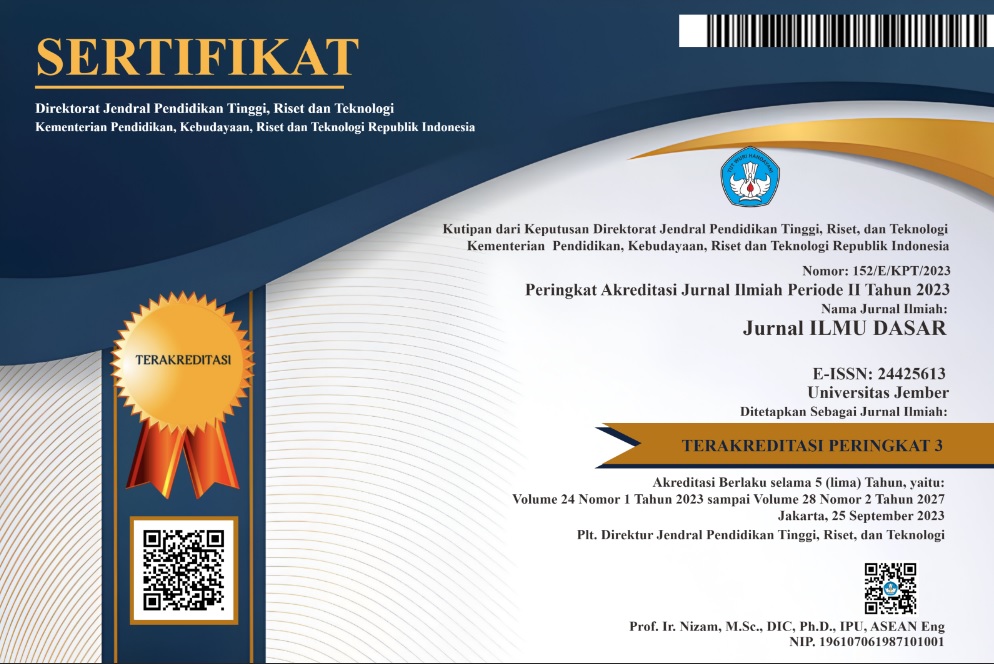Morphological Variation and Beta Carotene Contents of Several Clones of Ubi Kuning Cassava Genotype Derived from Irradiated Shoot in vitro
DOI:
https://doi.org/10.19184/jid.v21i2.9307Abstract
In line with the increase in cassava production and the development of nutrient-rich cassava in order to support national food diversification and biofortification programs, the selection of selected varieties of cassava varieties, which are superior in nutrients especially rich in beta carotene is very necessary. Beta carotene is an important source of antioxidants to scavange free radicals and is a provitamin A precusor to form vitamin A. The development of superior cassava riching in beta carotene can be done through the mutation approach with gamma irradiation. The observation of changes in morphological characters and levels of beta carotene from irradiated cassava need to be done to get the superior beta carotene cassava clone candidates, which could be developed in the future. This experiment was conducted at the Biotechnology Research Center, LIPI. The sample used in this study originated from in vitro shoots from several Ubi Kuning clones resulting from 10 Gy radiation, which were then transferred to the field. Observations of morphological characters and levels of beta carotene of Ubi Kuning were carried out in the third generation, which was harvested at the age of 10 months. The morphological analysis of irradiated Ubi Kuning showed that there was a difference in the intensity of tuber color between some of irradiated Ubi Kuning clones compared to the control. The determination of beta carotene levels based on the standard beta carotene curve found that the highest content of beta carotene was found in the UK Rad 3.4 clone with beta carotene content of 0.252 μg / mL compared to the control (0.219 μg / mL). The lowest beta carotene content was obtained in UK Rad 3.3 (0.048 μg / mL), followed by UK Rad 3.2 (0.221 μg / mL) and UK Rad 4.1 (0.120 μg / mL). This shows that the irradiated Ubi Kuning at dosage of 10 Gy caused variations in the intensity of tuber colors and the content of beta carotene from the cassava.
Keywords: Ubi Kuning, beta carotene, Gamma light irradiation
Downloads
References
Astawan M. 2008. Khasiat warna-warni makanan. Gramedia Pustaka Utama.
Devi L & Sastra, DR. 2006. Pengaruh Radiasi Sinar Gamma terhadap Kultur in vitro Tanaman Jahe. Jurnal Sains dan Teknologi Indonesia. 8(1): 7-14.
Harahap F. 2005. Induksi Variasi Genetik Tanaman Manggis (Garcinia mangostana) dengan Radiasi Sinar Gamma. Disertasi. ITB. Bogor.
Hartati S, Fitriani H, Supatmi S & Sudarmonowati E. 2012. Karakter Umbi & Nutrisi Tujuh Genotip Ubi Kayu (Manihot esculenta). Agricola, 2(2), 101-110.
Hartati NS, Fitriani H, Fathoni A, Hartati, Rahman N, Wahyuni & Sudarmonowati E. 2014. Budidaya Ubi Kayu Tinggi Beta Karoten dan 63 Prospek Pemanfaatannya. Seminar Nasional Hasil Penelitian Unggulan Bidang Pangan Nabati. Cibinong. LIPI.
Krisno MA & VV Agustine. 2012. Ubi Jalar Jingga atau Merah (Ipomea trifida) Sumber Beta-Karoten Mempengaruhi Fungsi Mata. https://aguskrisnoblog.wordpress.com/2012/06/28/ubi-jalar-jingga-atau-merah-ipomoea-trifida-suber-brta-karoten-mempengaruhi-fungsi-mata/. (diakses 17 Oktober 2019)
Lestari T, Mustikarini, ED, Apriyadi, R, & Anwar S. 2019. Early stability test of mutant candidates of Bangka local cassava, Indonesia. Biodiversitas Journal of Biological Diversity. 20(1): 337-342.
Maharani S, Khumaida N, Syukur M & Ardie SW. 2015. Radiosensitivitas dan Keragaman Ubi Kayu (Manihot esculenta Crantz) Hasil Iradiasi Sinar Gamma. Jurnal Agronomi Indonesia (Indonesian Journal of Agronomy). 43(2):111-117.
Moorthy SN, Jos JS, Nair RB & Sreekumari MT. 1990. Variability of β-carotene Content in Cassava Germplasm. Food Chemistry. 36(3):233-236.
Octaviani T, Any G & Susanti H. 2014. Penetapan Kadar β-Karoten Pada Beberapa Jenis Cabe (Genus Capsium) Dengan Metode Spektrofotometri Tampak. Jurnal Pharmaciana, 4(2): 101-109.
Rahman N. 2013. Daya Hidup dan Pertumbuhan Kultur In Vitro Ubi Kayu (Manihot esculanta) Genotip Ubi Kuning Hasil Radiasi. Prosiding Seminar Nasional Riset Pangan, Obat-obatan,Pangan dan Lingkungan Untuk Kesehatan. 1(4):409-414.
Sanusi RA & Adebiyi AE.2009. Beta carotene content of commonly consumed foods and soups in Nigeria. Pakistan Journal of Nutrition 8(9):1512-1516.
Soeranto H. 2003. Peran Iptek Nuklir dalam Pemuliaan Tanaman untuk Mendukung Industri Pertanian. Puslitbang Teknologi Isotop dan Radiasi. Badan Tenaga Nuklir Nasional (BATAN) Jakarta.
Soetanto E. 2008. Tepung Kasava dan Olahannya. Yogyakarta: Kanisius.
Widiastuti A, Sobir & Suhartanto MR. 2010. Analisis Keragaman Manggis (Garcinia mangostana) Diiradiasi dengan Sinar Gamma Berdasarkan Karakteristik Morfologi dan Anatomi. Nusantara Bioscience.2:23-33.








